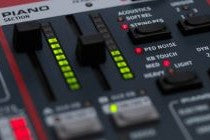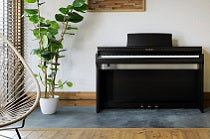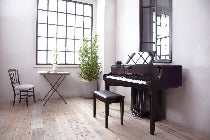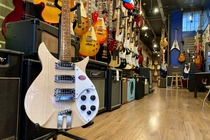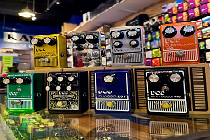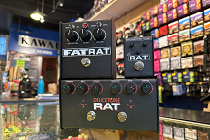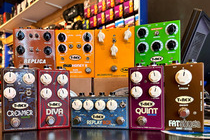It's at this point that I feel the urge to sit the skeptical customer down and ask 'Pugs aren't real dogs, are they?' 'Fender squires aren't real guitars, are they' and a myriad of other questions that they would hopefully easily object to.
So why do so many people assume ukuleles lack the integrity and potential of other instruments? Mind you, many of us have been scarred by a fleet of young primary school children bashing out dissonant renditions of Christmas songs, but this is just one side (fortunately) that opens up a gateway to a whole new world of music, whether that be via education, or interesting arrangements of your favourite classic-rock songs.
So yes.
Ukulele's are real instruments!
In fact, ukuleles have been in production since the late 1800's, making them one of the first instruments to be widely distributed, because of their size and affordability. So ukuleles aren't just for pre-schoolers playing in unison - pretty neat, huh? In saying that, once some non-believers get over the fact that, yes indeed, they can be just as versatile as any other instrument, it's difficult to tell where to start when purchasing a ukulele. Whether you are a seasoned pro, or a beginner looking for a bit of fun, the possibilities are endless, really.
SIZE MATTERS
Before selecting your ukulele, it's helpful to recall that there are four different sizes of ukulele; Soprano, Concert, Tenor, and Baritone. Gradually increasing in size respectively, each ukulele type listed above instigate different sounds, and body sizes that can affect projection, comfort, and overall play-ability.
The most common size, and also the smallest of the ukulele family, the Soprano, is often the most popular because of it's size and mid-range volume levels. This provides players with the confidence that they will be easy to transport, and they will be able to sing-along with the instrument without being drowned out by the volume, unlike some acoustic guitars. This size also works great for younger children, and song-writers who want an easy-access tool that won't break their backs on long tube journeys.
Concert ukuleles, which are the second smallest of the ukulele family, are slightly more versatile than their smaller counterparts, as they usually have longer bodies, and more frets. This may enhance the experience of the instrument, such as using a capo to change the key of the instrument, along with slightly larger frets which may be an easier transition for guitar players. This size is most popular with guitarists who are seeking a bit more versatility with the instrument, and those with larger hands who find that soprano ukuleles might just be a bit too small.
As far as body types go, there is no right or wrong answer to which size of ukulele trumps over the others. The type of ukulele depends on what one is looking for as far as sound, size, timbre, and volume.
If you're still not convinced, we offer a range of Guitar-ukuleles - and don't fret, they have 6 strings if you are unwilling to convert to the GCEA standard ukulele tuning.
MATERIALS
The next factor in choosing a ukulele is considering what kind of sound you are looking for. Although the size of the body is a large factor, the types of wood and their combinations are another key factor to consider if you're looking for a specific sound.
Spruce ukuleles, which are lighter in colour, tend to provide a brightener sound, whereas ukuleles made out of darker woods such as mahogany will provide a warmer and richer tone.
If you're after something in between, we stock Cordoba ukuleles made out of Ovankgol. This wood is similar to rosewood, but it has a slightly fuller mid-range sound.
We stock ukuleles made out of all of all the woods listed above and more, so you can find the exact sound and timbre you are looking for. Remember: different combinations of woods on the backs, sides, and fronts of the ukuleles will give you different sounds.
STRINGS
The most popular brand of strings are Nygut strings made by Aquila. These strings come stock on most of our models, including Cordoba, Laka, and Kala.
If you are just starting out, or playing for fun, the type of string doesn't matter too much- but if you're looking for a string that will last longer, and add a bit of extra 'oomph' to your sound, then it might be worth considering the switch, for only a few pounds more.
In conclusion, even though it may seem like a daunting task to chose a ukulele now that you know there are so many options, fear not- it's easier and more exciting than you may think, and the staff here at Rose Morris are happy to help you find the perfect fit.
And if you're still not convinced, check out Jake Shimabukuro's version of a beloved Queen classic.

